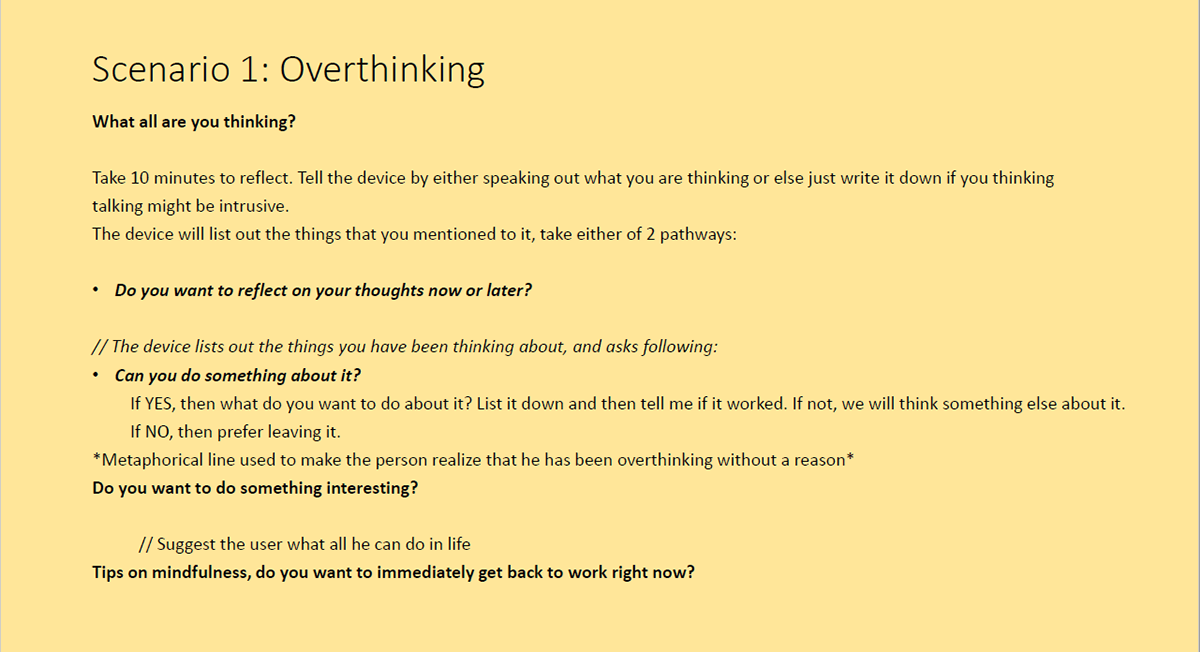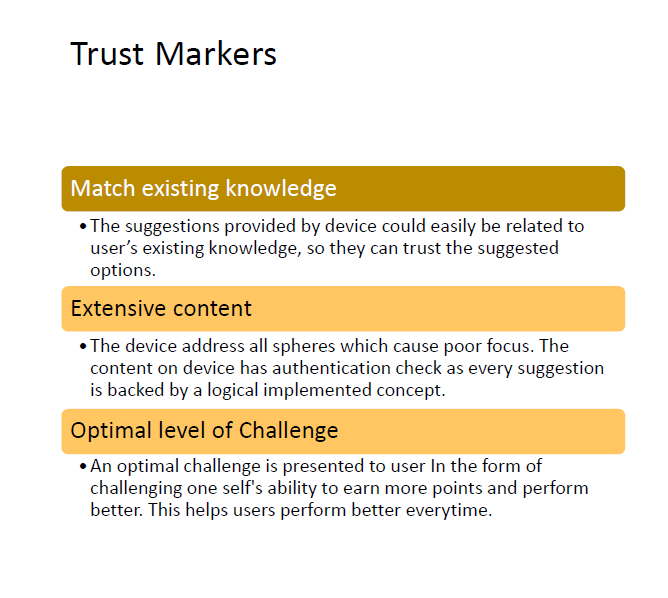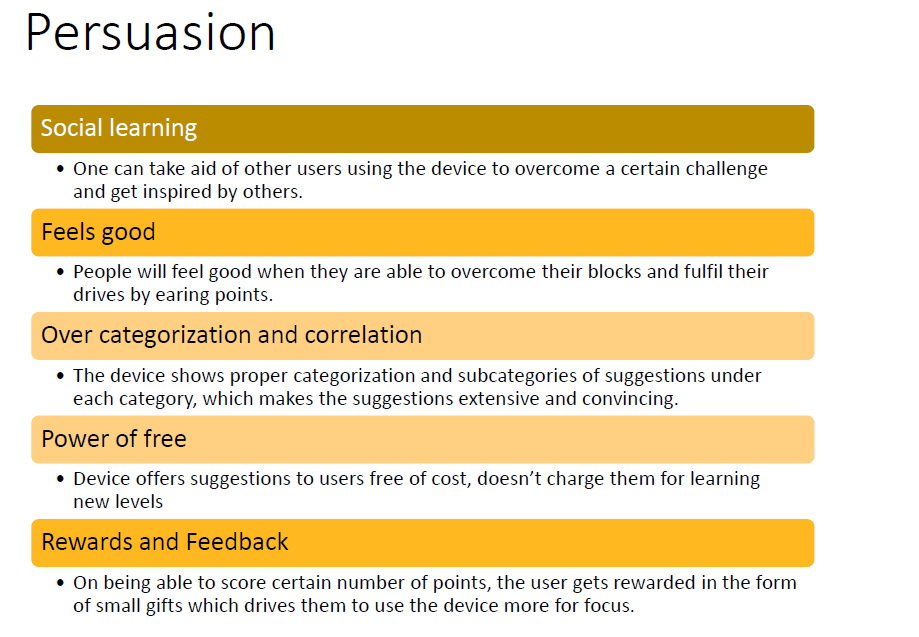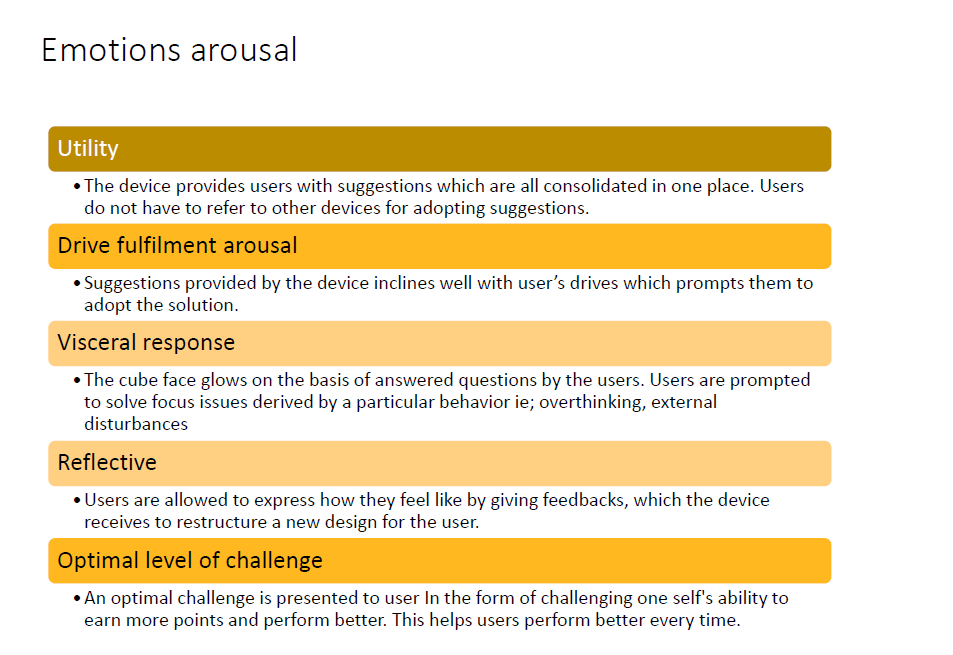FOCUS CUBE
The artefact focus cube is an attempt to alter the behavioral patterns of individuals who have trouble focusing. It tries to utilize the Principles of PET theory to attach value to the intentions of the product.
The habits of a user are closely tied to the psychology of users which determine their mind sets. Mind sets further determine the belief system, with further determine the thoughts that a user usually has. Thoughts in our minds manifest themselves as actions we perform, and repetition of certain actions in the form of ritual define our HABITS.
I started off by doing secondary research so as to what are factors and habits of users that are responsible for poor focus. So, I set my process of designing an artifact by approaching my users to understand their mind sets. I mapped several attitude and behavioral patterns after interviewing 12 users who had trouble focusing.
From the interviews I wanted to extract what causes users to perform certain actions which contribute to their focus problems. I then arrived at the behavioral patterns which were driving them to focus better and the blocks which were interfering in their ability to focus. While plotting the drives and blocks, I attempted to plot the feelings and believes of the users to be better able to understand the existing mind sets of the users. I could clearly draw a pattern that that the beliefs of the users were somewhere closely related to how they feel while attempting to focus on something.


After plotting the above for each participant, I wanted to sort of maximum recurring patterns for the participants I had interviewed. From that I listed the patterns which are mostly recurring and tried to understand the intensity of the drives and blocks by mapping them from surface to strong intensities .This was done to further clarify what behavior is most responsible to steer them away from forming an intended habit and which behavior will help them the most.


Understanding the User context
After this, making a general PET persona which would help me understand the user in different spheres like Demographics, psychology, ease with technology, existing habits, attitude, feelings and believes. I also aimed at capturing the behavioural goals which would help me align the goals of my product with the intended goals by the user. This helped me build a better understanding of User context. This is what I found important to set off performing further steps in my process.


I then performed some secondary research to see already existing solutions to improve focus, which kind of aligned quite well with my insights of how to improve focus
I further mapped user journeys to understand a typical day in user’s life. This was drawn in through the interviews I took. User journeys helped me understand where all I could use persuasion at various instances during a day. This was done by listing emotions at those instances and identifying the behavioural responses in those instances.


Then I started to brainstorm to ideate on finding solutions from the developed insights and tried to develop a persuasive flow on its basis. Some factors which I considered while developing a Persuasive flow while ideating on an artefact were:
Make it personal: The persuasive power of Customisation
Anytime users can have a sense of ownership and control over a decision, they feel empowered and are more apt to adopt and adapt. When we put the power to choose into the hands of our customers, users have a sense of ownership which increases satisfaction levels and builds a willingness to assist in improve the performance of the product.
As designers, we should include users in the design and decision making process so that the process becomes much more suitable to achieve their intended goals.
The science of rewards and gains
The psychology behind this step is to emphasize gains in order to encourage certain behavior. When a loss is significant enough, users will see the value in the gain and find the experience more pleasurable.
Craft the journey for a good user experience
Design is about the experience which should be enjoyable by users. When the journey is enjoyable, users want more. However, you can’t make an enjoyable process without knowing your users. Understanding the pain-points, knowing the culture, and personifying the users based on known demographic information. Personas are hence important in knowing the user end to end.
Set up the options: Setting the stage for the desired outcome
Our users want options; they want the power to choose. Because consumers can choose a behavior that a designer doesn’t desire, it is important to design the decisions so that the choice you want the user to choose is more compelling than the alternative.
Avoiding undesirable outcomes
It is important to not overwhelm the user with an excessive amount of content or an endless number of decisions. When users become overwhelmed, they shut down and disregard the outcome in order to complete the task at hand. The product should hence even guide the user in making decisions.
Ideations
With the above points I came up with my first idea of implementing a focus cube, which was very similar to my final idea. So let me take you through the final idea and then I would mention the limitations I overcame in my initial idea to reach here.

A) The role of device when the user had to switch to his mobile device only to adopt to suggestions provided. This could further deviate the user, instead of helping him attend to the cause behind poor focus.
B) The device also had a leadership board in which the user cn compare his performance to fellow users logged onto device. This could discourage user in case the user wasn’t able to address the reason of poor focus.
Focus cube is a AI powered assistance providing device which could help people address various reasons of not being able to focus. These according to my research were:
A) Anxiety
B) Overthinking
C) External Disturbances
D) Random thoughts
E) Emotional Disturbances
The device comes with a keyboard which the user can use to feed inputs to the device, or the user can speak to the device. Every time a user feels distracted, he can approach the device and the device requires the user to answer a certain set of questions to understand the possible cause and provide suggestions to users, and the user performance of adopting to the suggestions can be logged onto device. 5 faces of the device address each of these.


The initial ideation had the cube synced to the apps on user’s mobile device and suggested users to download the apps and perform specific tasks on the mobile device. Limitations of the initial approach were:
A) The role of device when the user had to switch to his mobile device only to adopt to suggestions provided. This could further deviate the user, instead of helping him attend to the cause behind poor focus.
B) The device also had a leadership board in which the user can compare his performance to fellow users logged onto device. This could discourage user in case the user wasn’t able to address the reason of poor focus.
To understand the logical flow of how the device will address each of these issues I jotted down case scenarios which the device would possibly be addressing.





Persuasive Flow
I followed the PET toolkit stated by HFI to design a suitable persuasive flow for the device. the PET Design™ toolkit is about designing for persuasion, emotion and trust.
1) Trust techniques are for establishing credibility, providing assurances and removing risk.
2) Emotion is a prime determinant of the sense of subjective well-being. Emotion-based techniques are about eliciting a desired emotional response during a process.
3) Persuasion techniques — the triggers to an action. These techniques relate to the mechanics.



Design of any product or service should go beyond the intention of just letting it out in the market and and exploring in depth about the sales of the product. A user needs to be persuaded and perceive the persuasive flow as intended by the designer. It is hence very important to understand the intentions, goals and motivations of a user to opt for a certain service or product and embed it in the design process. It is only then that usability of the product will be able to reflect its purpose, else the design is confined only to the designer’s knowledge horizon, little to what exactly the product should intend to achieve.


